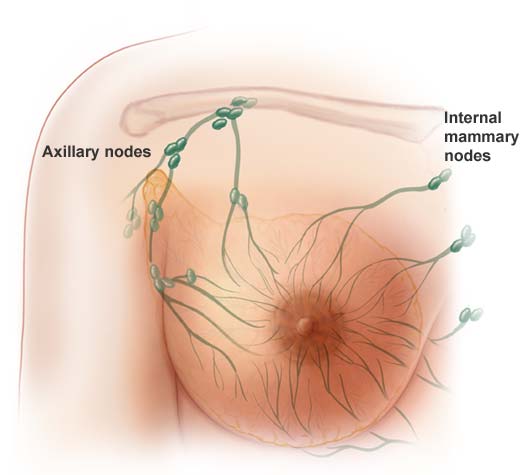Understanding breast cancer and risk factors for developing breast cancer

Anatomy of the breasts
It is important to understand the structure and location of the breasts and the structures connecting the breasts to the rest of the body enabling them to function as glands.
The breasts are gland-containing organs situated on the front of the chest. Each breast consists of 15 to 20 lobes, which are sections of glandular tissue that together make up the breast as a whole. Within the lobes are many smaller sections called lobules. Lobules contain groups of tiny glands that can produce milk. Milk flows from the lobules through thin tubes called ducts to the nipple. The nipple is in the center of a dark area of skin called the areola. Fat fills the spaces between the lobules and ducts.
The tissue and glands of the breast are connected to the rest of the body via lymph and blood vessels (arteries and veins). Lymph vessels are similar to blood vessels. However, they contain lymphatic fluid, a type of body fluid that contains white blood cells, the immune cells that defend the body against infection and disease. These lymph vessels lead to small, round organs called lymph nodes, sometimes called lymph glands. Some groups of lymph nodes are situated near the breast in the axilla (underarm). Other lymph nodes are situated in locations near the breast including above the collarbone and in the chest behind the breastbone. The lymph nodes trap bacteria, cancer cells, or other harmful substances and, therefore, are involved in the body's immune response to disease.
In 2007 the American Cancer Society (ACS) estimates that breast cancer is the most common cancer to be diagnosed in women and the second most common cause of cancer death in women after lung and bronchial cancer. Also according to the ACS one in eight American women are at risk of developing breast cancer in their lifetime. Scientists are studying breast cancer to learn more about its causes, and they are looking for better ways to prevent, find, and treat it.
Cancer is a disease that begins in cells, the building blocks that form the tissues. Tissues make up the organs of the body. Normally, cells grow and divide to form new cells as the body needs them. When cells grow old, they die, and new cells take their place. Sometimes, this orderly process breaks down. New cells form when the body does not need them, and old cells do not die when they should. These extra cells can form a mass of tissue called a growth or tumor.

Anatomy of the breasts
It is important to understand the structure and location of the breasts and the structures connecting the breasts to the rest of the body enabling them to function as glands.
The breasts are gland-containing organs situated on the front of the chest. Each breast consists of 15 to 20 lobes, which are sections of glandular tissue that together make up the breast as a whole. Within the lobes are many smaller sections called lobules. Lobules contain groups of tiny glands that can produce milk. Milk flows from the lobules through thin tubes called ducts to the nipple. The nipple is in the center of a dark area of skin called the areola. Fat fills the spaces between the lobules and ducts.
The tissue and glands of the breast are connected to the rest of the body via lymph and blood vessels (arteries and veins). Lymph vessels are similar to blood vessels. However, they contain lymphatic fluid, a type of body fluid that contains white blood cells, the immune cells that defend the body against infection and disease. These lymph vessels lead to small, round organs called lymph nodes, sometimes called lymph glands. Some groups of lymph nodes are situated near the breast in the axilla (underarm). Other lymph nodes are situated in locations near the breast including above the collarbone and in the chest behind the breastbone. The lymph nodes trap bacteria, cancer cells, or other harmful substances and, therefore, are involved in the body's immune response to disease.
In 2007 the American Cancer Society (ACS) estimates that breast cancer is the most common cancer to be diagnosed in women and the second most common cause of cancer death in women after lung and bronchial cancer. Also according to the ACS one in eight American women are at risk of developing breast cancer in their lifetime. Scientists are studying breast cancer to learn more about its causes, and they are looking for better ways to prevent, find, and treat it.
Cancer is a disease that begins in cells, the building blocks that form the tissues. Tissues make up the organs of the body. Normally, cells grow and divide to form new cells as the body needs them. When cells grow old, they die, and new cells take their place. Sometimes, this orderly process breaks down. New cells form when the body does not need them, and old cells do not die when they should. These extra cells can form a mass of tissue called a growth or tumor.

0 comments